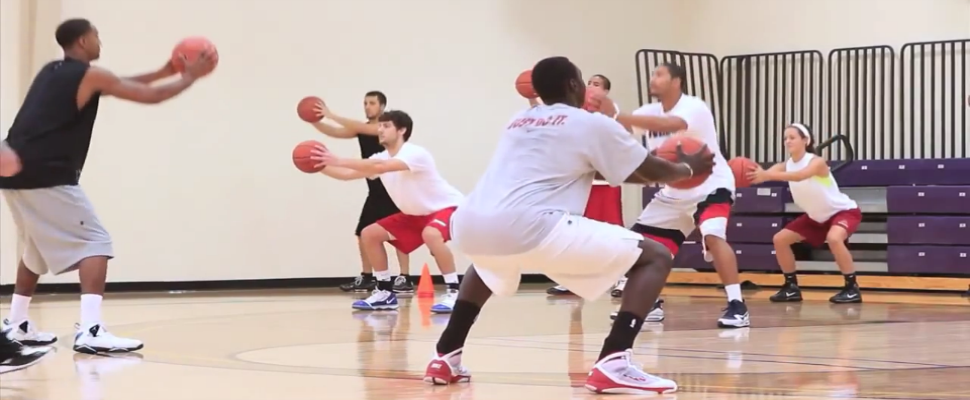BASKETBALL
Types of Training
From 52-Week Basketball Training by Chip Sigmon
In addition to traditional strength training exercises that focus on particular areas of the body, I also incorporate several other strengthening methods that are specifically suited to basketball. Basketball is a sport combining absolute strength with vertical explosive power, followed by powerful lateral movement. All of this can be done in a very short amount of time, such as going after one rebound. This is why resistance training must simulate and overload these movements. Following is a list of several training methods to use to combine lifts or work in sets to improve basketball skills.
Contrast training is one way to simulate the strength and power of basketball movements. A contrast training exercise might start out with the squat or leg press, and then go right to a power slide or body blade for stability. Another example of a good contrast training exercise is performing an upper body movement such as a bench press, then immediately going to medicine ball throws. Contrast training is a valuable tool to enhance your basketball skills.
Complex training is similar to contrast training except that it involves resistance training with no jumping or lateral work. A complex training set we use is performing a hang clean for five reps, then at the top of the fifth clean movement going into a front squat. After five reps of the front squat, you go directly to a push press for five reps. Again, this increases the intensity of the workload and also increases the metabolic rate of the body, which really burns calories.
Circuit training involves doing three or more different exercises without any (or with very little) rest between exercises. After a 60- to 90-second rest, you repeat the circuit. The circuit can combine absolute strength exercises and explosive movements or separate them. A circuit training workout can be all abdominals, all upper body work, or all lower body work; however, the circuit programs for basketball players ideally include both upper and lower body exercises for a total body workout.
Supersetting is consistently used throughout the 52-week program. You will see an SS noted in many of the workouts. It simply means that after performing one exercise of a particular body part you go directly to the next exercise that works the same body part with very little or no rest in between. In some situations supersetting may be a form of contrast training. Again, the idea is to overload the muscles to build strength and muscular endurance.
Combination movements are much like supersets except that you are training two different body parts instead of similar body parts. When you see CS noted in a workout, it means you should go from one exercise to another with little rest in between.
A metabolic 3 X 3 workout is a multijoint hip movement, followed by a multijoint chest exercise, followed by a multijoint upper back movement. I have incorporated this workout into the in-season training because of its short duration (20 to 25 minutes). Once again, you should move as quickly as possible between exercises with 60 to 90 seconds of rest between “tri-sets.” Every set can be trained either short of failure or to complete failure, depending on your schedule of games. You may want to come short of failure if you have a game the day after your 3 X 3 workout. If you have more time to recover, however, (at least three days), a workout to complete failure may be called for.
Matrix workouts take you through three planes of movement rather than one or two as is the case with most resistance exercises.
Plyometrics are drills aimed at linking strength with speed of movement to produce power. Plyometrics and the training involved are essential to athletes who jump, lift, or run.
Tubing exercises use special types of light to heavy tubing to vary the resistance during a movement. Tubing may be used in stretching exercises and can be incorporated with your weight training program. Exercises such as rowing movements for the back and even leg training can help supplement your workout or warm up your body in preparation for the upcoming workout session. Now that we have highlighted several ways to combine lifts to enhance your game, let’s cover the basics of each strength exercise.
Some Dos and Don’ts of Resistance Training
Be sure to do the following:
-Rotator cuff exercises before all bench press work.
-Light leg extensions before any other leg extensions.
-Breathe correctly when performing each lift-breathe in when lowering the resistance and out during the exertion phase of the lift.
Be sure not to do the following:
-Leg extensions in which you straighten the knee completely if you have had knee surgery of any kind (especially ACL surgery). Straightening the knee completely puts too much pressure on the ligaments or tendons that have been repaired.
-Behind-the-neck lat pull-downs, behind-the-neck presses, upright rows, and incline bench presses using a bar. These four exercises put too much strain on the rotator cuff and can cause damage to the area over a long period of time.
-Supine (lying) bench presses with a bar if you have had any type of shoulder surgery. Use a machine or dumbbells instead.
Types of Training
From 52-Week Basketball Training by Chip Sigmon
In addition to traditional strength training exercises that focus on particular areas of the body, I also incorporate several other strengthening methods that are specifically suited to basketball. Basketball is a sport combining absolute strength with vertical explosive power, followed by powerful lateral movement. All of this can be done in a very short amount of time, such as going after one rebound. This is why resistance training must simulate and overload these movements. Following is a list of several training methods to use to combine lifts or work in sets to improve basketball skills.
Contrast training is one way to simulate the strength and power of basketball movements. A contrast training exercise might start out with the squat or leg press, and then go right to a power slide or body blade for stability. Another example of a good contrast training exercise is performing an upper body movement such as a bench press, then immediately going to medicine ball throws. Contrast training is a valuable tool to enhance your basketball skills.
Complex training is similar to contrast training except that it involves resistance training with no jumping or lateral work. A complex training set we use is performing a hang clean for five reps, then at the top of the fifth clean movement going into a front squat. After five reps of the front squat, you go directly to a push press for five reps. Again, this increases the intensity of the workload and also increases the metabolic rate of the body, which really burns calories.
Circuit training involves doing three or more different exercises without any (or with very little) rest between exercises. After a 60- to 90-second rest, you repeat the circuit. The circuit can combine absolute strength exercises and explosive movements or separate them. A circuit training workout can be all abdominals, all upper body work, or all lower body work; however, the circuit programs for basketball players ideally include both upper and lower body exercises for a total body workout.
Supersetting is consistently used throughout the 52-week program. You will see an SS noted in many of the workouts. It simply means that after performing one exercise of a particular body part you go directly to the next exercise that works the same body part with very little or no rest in between. In some situations supersetting may be a form of contrast training. Again, the idea is to overload the muscles to build strength and muscular endurance.
Combination movements are much like supersets except that you are training two different body parts instead of similar body parts. When you see CS noted in a workout, it means you should go from one exercise to another with little rest in between.
A metabolic 3 X 3 workout is a multijoint hip movement, followed by a multijoint chest exercise, followed by a multijoint upper back movement. I have incorporated this workout into the in-season training because of its short duration (20 to 25 minutes). Once again, you should move as quickly as possible between exercises with 60 to 90 seconds of rest between “tri-sets.” Every set can be trained either short of failure or to complete failure, depending on your schedule of games. You may want to come short of failure if you have a game the day after your 3 X 3 workout. If you have more time to recover, however, (at least three days), a workout to complete failure may be called for.
Matrix workouts take you through three planes of movement rather than one or two as is the case with most resistance exercises.
Plyometrics are drills aimed at linking strength with speed of movement to produce power. Plyometrics and the training involved are essential to athletes who jump, lift, or run.
Tubing exercises use special types of light to heavy tubing to vary the resistance during a movement. Tubing may be used in stretching exercises and can be incorporated with your weight training program. Exercises such as rowing movements for the back and even leg training can help supplement your workout or warm up your body in preparation for the upcoming workout session. Now that we have highlighted several ways to combine lifts to enhance your game, let’s cover the basics of each strength exercise.
Some Dos and Don’ts of Resistance Training
Be sure to do the following:
-Rotator cuff exercises before all bench press work.
-Light leg extensions before any other leg extensions.
-Breathe correctly when performing each lift-breathe in when lowering the resistance and out during the exertion phase of the lift.
Be sure not to do the following:
-Leg extensions in which you straighten the knee completely if you have had knee surgery of any kind (especially ACL surgery). Straightening the knee completely puts too much pressure on the ligaments or tendons that have been repaired.
-Behind-the-neck lat pull-downs, behind-the-neck presses, upright rows, and incline bench presses using a bar. These four exercises put too much strain on the rotator cuff and can cause damage to the area over a long period of time.
-Supine (lying) bench presses with a bar if you have had any type of shoulder surgery. Use a machine or dumbbells instead.

Basketball Training on Long Island














